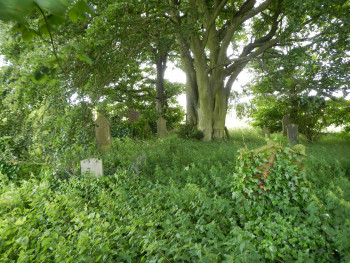- Navigation:
- Back to the Corpus index page
- RSS
Kirkbuddo / Crebyauch Parish Church
Kirkbuddo churchyard, 1
- Dedication: unknown
- Diocese of Brechin
- NO 49335 43273
Summary description
Nothing remains of any church within the small and overgrown churchyard that is presumed to have been its location; the only indicator of a possibly medieval use of the site is a cross-incised slab that has evidently been adapted as a door or window lintel.
Historical outline
The early history of the church and parish of Kirkbuddo has left no surviving trace in the record. It is not mentioned in Bagimond’s Roll nor is there any evidence for its earlier appropriation to any religious corporation. It was apparently a free parsonage down to the later fifteenth century but Ian Cowan’s suggestion that both the parsonage and vicarage were erected in 1479 into a prebend of the recently-founded collegiate church of Guthrie by Pope Sixtus IV is not borne out by the papal confirmation of the foundation, which names Kirkforthar.(1) Nevertheless, a connection with Guthrie was made, possibly early in the sixteenth century, for at the Reformation James Guthrie, parson and prebendary of Guthrie, was noted as holding the parsonage and vicarage of Kirkbuddo.(2) This union continued into the seventeenth century, with ministers serving both parishes down to at least 1682.
Notes
2. Kirk (ed), Book of Assumptions of Thirds of Benefices, 391.
Summary of relevant documentation
Medieval
Synopsis of Cowan’s Parishes: The parsonage and vicarage were erected into a prebend of the Collegiate church of Guthrie in 1479, with the cure a vicar pensionary. [Not mentioned in foundation charter, maybe Kirkforthar?](1)
[No pre-Reformation references]
Post-medieval
Books of assumption of thirds of benefices and Accounts of the collectors of thirds of benefices: The Parish church prebend of college of Guthrie; parsonage held by James Guthrie, value £24 with pasche fines etc, £20 without.(2)
Account of Collectors of Thirds of Benefices (G. Donaldson): Third of parsonage and vicarage £6 13s 4d.(3)
[The parish seems to have been united to Guthrie sometime in the 16th century. The minister served at both churches until 1682. Also known as Carbuddo.]
Bibliography
1. Cowan, I.B., 1967, The parishes of medieval Scotland, (Scottish Record Society), Edinburgh.
2. Donaldson, G., 1949, Accounts of the collectors of thirds of benefices, (Scottish History Society), Edinburgh.
3. Kirk, J., 1995, The books of assumption of the thirds of benefices, (British Academy) Oxford.
Architectural description
Early Christian activity on this site would appear to be attested by the location of a severely weathered cross slab in the churchyard in 1949, which was donated to the Meffan Institute in Forfar in 1989.(1) In 1479 both the parsonage and vicarage of the church were erected by Pope Sixtus IV into a prebend of Guthrie Collegiate Church, and it seems that the cure was then pensionary.(2)
The parish was evidently united with that of Guthrie at some point in the sixteenth century, though the minister seems to have continued to serve both churches into the eighteenth century. The fact that there was no church there by the nineteenth century was a matter of regret to the minister, who commented in the New Statistical Account:
The southern or Carbuddo division of the parish labours under great disadvantages in respect of church accommodation...There is no place of worship in that locality, nor has there been for many years.(3)
The church is assumed to have been in a small and heavily overgrown churchyard at NO 49335 43273, which is enclosed by a stone wall with a single locked gate, and now surrounded by barbed-wire fences and thick undergrowth. Nothing remains of any church, though it may have been where there is now a burial enclosure. The only medieval artefact to remain at the site is a cross slab, which appears to have been re-used as the lintel of a door or window, leaving no more than a part of the cross head visible. It has been said that there was a font in the churchyard,(4) though it could not be found at the time of the visit.
Notes
1. Royal Commission on the Ancient and Historical Monuments of Scotland, Early Medieval Sculpture in Angus Council Museums, Edinburgh, 2005; Norman K. Atkinson, ‘Curators of Last Resort’, in Sally M. Foster and Morag Cross (eds), Able Minds and Practised Hands (Society for Medieval Archaeology Monographs, no 23), Leeds, 2005, p. 337.
2. Ian B. Cowan, The Parishes of Medieval Scotland (Scottish Record Society), 1967, p. 118.
3. New Statistical Account of Scotland, 1834-45, vol. 11, p. 474.
4. A.J. Warden, Angus or Forfarshire: the Land and People, Descriptive and Historical, Dundee, 1880-85, vol. 3, p. 394.
Map
Images
Click on any thumbnail to open the image gallery and slideshow.






